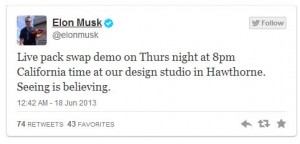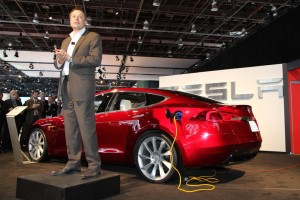Barely a month after announcing plans to set up a high-speed network of “Supercharger” stations across the U.S. and Canada, Tesla CEO Elon Musk is hinting the start-up electric vehicle maker might also adopt a battery swap system that could allow owners of the new Model S sedan to have a freshly charged battery pack “faster than you could fill a gas tank.”
Tesla has been exploring the idea of swapping batteries for a number of years. The approach is, at least conceptually, quite simple. When one battery pack runs down, simply switch it out for another, much like changing batteries in a flashlight. But, in practice, it’s a lot more difficult than it might seem.
“Live pack swap demo on Thurs night. Seeing is believing,” tweeted Tesla Musk this week. The South African-born executive is fond of using Twitter to alert friends, fans and the media of the company’s plans, including news of the expanded Supercharger network.
Battery cars sales have been lagging behind expectations and observers point to several explanations, including the high cost of the technology. Then there’s the issue of limited range and the long charge times needed to “fill” batteries back up.
 Even using 220-volt current, it can take a good portion of a day to charge up most battery vehicles but there is a push to expand the availability to 440-volt DC, or Level III, charging systems. Last week, BMW and General Motors agreed on a new industry standard for those chargers – with other makers expected to sign on – that could lead to their rapid proliferation across the U.S.
Even using 220-volt current, it can take a good portion of a day to charge up most battery vehicles but there is a push to expand the availability to 440-volt DC, or Level III, charging systems. Last week, BMW and General Motors agreed on a new industry standard for those chargers – with other makers expected to sign on – that could lead to their rapid proliferation across the U.S.
(Automakers agree on new high-speed charging standard. Click Here.)
Separately, Tesla last month announced plans to more than double the number of its own high-speed Supercharger stations, which it claims can give up to an 80% recharge in 20 minutes. That is, however, significantly longer than it might take a comparable gas vehicle to fill up, a particular hassle on long trips.
(Tesla to expand Supercharger network across North America. Click Herefor the story.)
So, it seems, Tesla has another option up its corporate sleeve. Musk recently sent out another tweet, hinting, “There is a way for the Tesla Model S to be recharged throughout the country faster than you could fill a gas tank.”
That’s where a battery swap could come in. In most battery-electric vehicles, such a process could be difficult to impossible. The pack in the Chevrolet Volt plug-in hybrid, for example, is a complex, integral part of the vehicle structure. It would take hours to accomplish.
In a vehicle designed for that concept the operation could be as simple as changing batteries in a flashlight, however, and might take a matter of minutes.
(Battery-car start-up Detroit Electric faces delays. For more, Click Here.)
Tesla had hinted it might design in the capability of swapping batteries when it began working on the Model S, but there had been little discussion of the concept since then.
The electric sedan uses thousands of D-Cell-sized lithium-ion batteries hidden in the underlying platform of the vehicle. Apparently, there’s a quick way to pull them out and slide in replacements.
Tesla isn’t the only maker that has explored battery swapping. Nissan worked with an Israeli company, Project Better Place, to develop a similar operation. Unfortunately, the Israeli firm failed to generate much enthusiasm and after selling less than 1,000 vehicles it folded shop earlier this month.
It’s unclear if the Japanese automaker will continue to explore battery swapping. It decided not to use that approach when it launched the Nissan Leaf in the U.S. nearly three years ago.
Customers who buy the longest-range version of the Tesla Model S automatically can use the company’s Supercharger network. It is an option customers can buy with the shorter-range battery-sedan.
If Tesla does decided to make battery-swapping available to its owners it remains to be seen if they will have to pay an additional fee for the convenience of further cutting their wait times for fully-charged vehicles.
Expect to find out more by Thursday evening.


I think this idea is even dumber than the fast charging systems. Are owners really going to drive 25+ miles out of their way to swap batteries or get a fast re-charge? Not many.